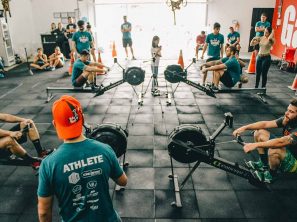Whole Body Vibration and Resistance Training Compare
Sixty-seven untrained females (21.4 ± 1.8 yr) participated in the study. The whole-body vibration group (WBV, N = 18) and the placebo group (PL, N = 19) performed static and dynamic knee-extensor exercises on a vibration platform. The acceleration of the vibration platform was between 2.28 g and 5.09 g, whereas only 0.4 g for the PL condition. Vibration (35-40 Hz) resulted in increased EMG activity, but the EMG signal remained unchanged in the PL condition. The resistance-training group (RES, N = 18) trained knee extensors by dynamic leg-press and leg-extension exercises (10-20 RM). All training groups exercised 3× wk-1. The control group (CO, N = 12) did not participate in any training. Pre- and postisometric, dynamic, and ballistic knee-extensor strength, were measured by means of a motor-driven dynamometer. Explosive strength was determined by means of a counter-movement jump.
Isometric and dynamic knee-extensor strength increased significantly (P ‹ 0.001) in both the WBV group (16.6 ± 10.8%; 9.0 ± 3.2%) and the RES group (14.4 ± 5.3%; 7.0 ± 6.2%), respectively, whereas the PL and CO group showed no significant (P > 0.05) increase. Counter-movement jump height enhanced significantly (P ‹ 0.001) in the WBV group (7.6 ± 4.3%) only. There was no effect of any of the interventions on maximum speed of movement, as measured by means of ballistic tests.
WBV, and the reflexive muscle contraction it provokes, has the potential to induce strength gain in knee extensors of previously untrained females to the same extent as resistance training at moderate intensity. It was clearly shown that strength increases after WBV training.
https://vibraprofitness.com/buyers-guide/Whole-body vibration (WBV) is a neuromuscular training method that has recently been developed. In WBV training, the subject stands on a platform that generates vertical sinusoidal vibration at a frequency between 35 and 40 Hz. These mechanical stimuli are transmitted to the body where they stimulate in turn sensory receptors, most likely muscle spindles. This leads to the activation of the alpha-motoneurons and initiates muscle contractions comparable to the earlier described tonic vibration reflex (6,11,15). Initially, WBV training was used in elite athletes to improve speed-strength performance. More recently, it is becoming tremendously popular in European health and fitness clubs as an alternative training method. Bosco et al. (3,5) found an increase in force-velocity, force-power and vertical-jump performance immediately after one WBV session. A placebo controlled study showed that a single bout of WBV transiently improves isometric strength of the knee extensors and vertical-jump performance by 3.2% and 2.5%, respectively (22). These effects were recorded 2 min after the intervention but disappeared in the next 60 min.
Some studies analyzed the effect of WBV training on muscle performance over a longer period. Bosco et al. (2) reported the effect of a 10-d training program of a daily series (5 × 90 s) of vertical sinusoidal vibrations at a frequency of 26 Hz. They found a significant improvement of the height and mechanical power during the 5-s continuous-jumping test. It was suggested that WBV training finally might result in neuromuscular adaptations similar to the effect produced by explosive strength training. However, 10 d of training is too short to determine the long-term effects of WBV. Runge et al. (20) showed gains of 18% in chair-rising time in elderly persons after 12 wk WBV training (27 Hz). Recently, Torvinen et al. (23) reported a significant increase in jump performance (8.5%) and a nonsignificant increase in isometric limb extension strength (2.5%) after a 4-month WBV intervention (25-30 Hz) in young nonathletic adults. As none of these long-term studies were placebo controlled, it is impossible to determine whether the training effect on strength and jump performance resulted from the exercises that were performed on the platform or from the vibration induced muscle activation.
This is the first long-term study to differentiate between the effects resulting from the exercises performed on the platform with vibration and without vibration (placebo) and to compare the effects of WBV training and resistance training by means of weight machines at moderate intensity. Therefore, the changes in isometric, dynamic, ballistic knee-extensor strength, and counter-movement jump (CMJ) height were analyzed in young female adults after a 12-wk training period. As WBV elicits a high degree of muscle activation, it was hypothesized that WBV would result in strength increase in previously untrained persons. These strength increases should be significantly larger than the training effects resulting from an identical exercise program performed in absence of vibration (placebo condition). As the tonic vibration reflex facilitates the activation of high-threshold motor units and the reflex sensitivity (1,18), WBV training may be more efficient to improve ballistic strength and jump performance compared with resistance training at moderate intensity.
Source: Medicine and Science in Sports and Exercise
Other News


